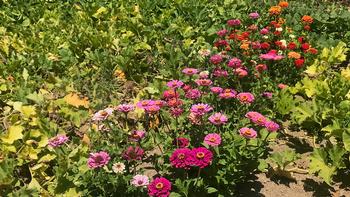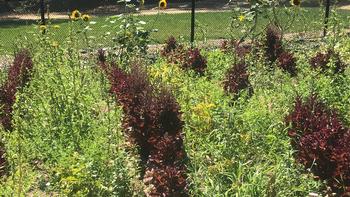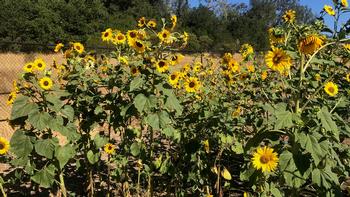Friends among plants
-
Marty Nelson
-
Plants depend on multiple interactions with the environment and each other to survive. Companion planting as a gardening technique has been practiced for generations based on discoveries about how bringing two or more plant species together can provide mutual advantages and enhance growth and production. The classic example is the Native American “three sisters” plantings combining corn, beans, and squash. Ideally, the corn provides structure to support the pole beans, and the squash spreads out underneath the other plants. The best plant companions do more than just grow well side-by-side. They interact and form partnerships that benefit one or more of them.
 Flowering plants attract pollinators and beneficial insects to an edible garden. Photo: Marty Nelson
Flowering plants attract pollinators and beneficial insects to an edible garden. Photo: Marty NelsonMany old beliefs about which plants make good companions are based on folklore or trial and error rather than sound science. Fortunately, numerous credible studies and controlled experiments are now helping explain the ecosystems that enable garden plants to thrive. In addition, there are many ways in which one plant can influence another by either enhancing conditions for growth or increased protection against threats.
Plants can help create a friendlier environment for other plants. Certain plant partners can improve soil composition by breaking up heavy soil or assisting in nitrogen transfer. For example, fava beans are good soil conditioners because they fix nitrogen in the soil, making it available to other plants. Plant partners can also promote the health of beneficial soil-dwelling organisms and assist in the movement of nutrients within the soil. Peas and lettuce play well together because both are cool-season crops with different growth structures. The peas climb while the lettuce stays low. The peas benefit the lettuce by shading them in warmer weather and providing nitrogen via the mycorrhizal network. Growing different varieties of plants together increases garden diversity with beneficial results. Photo: Marty Nelson
Growing different varieties of plants together increases garden diversity with beneficial results. Photo: Marty NelsonFlowering plants are important companions to fruit trees and edible plants. They can increase the number and diversity of pollinators leading to higher yields. They can also produce chemical and visual cues that confuse insect pests and make it harder for them to find their preferred host plant on which to feed or lay eggs. Combining members of the aster family (which includes coreopsis, yarrow, zinnias, and marigolds) with cabbage, broccoli, cauliflower, kale, and other members of the cabbage family has been shown to reduce aphid numbers by attracting beneficial, aphid-eating insects. Nasturtiums can help reduce squash bug populations.
Some plants act as traps to lure insect pests away from other plants. Pak choi and radish, for example, are favorites of flea beetles. Planting radish or pak choi a few weeks ahead of new peppers, eggplant, or other transplants can serve to trap the flea beetles and reduce damage to the other vegetables. The combination of basil and tomatoes works as well in the garden as it does in the kitchen. In this example, the basil masks the tomato plants from thrips, small sucking insects that can damage tomato plants and fruit.
Some plants cannot be friends. Plants that produce allelopathic chemicals can negatively influence the growth of other plants. Black walnut trees are notorious for not letting other plants get close. Surprisingly, although sunflowers are good companions for many plants, they have allelopathic properties that inhibit the growth of potatoes and pole beans. Allelopathic interactions can be an advantage in managing weeds without herbicides. Some common cover crops, such as winter rye, can be allelopathic when left in place as mulch. Weed seeds are prevented from germinating, but transplants of tomatoes, peppers, eggplants, and other vegetables are not harmed. Sunflowers are friendly to some plants and tough on others.. Photo: Marty Nelson
Sunflowers are friendly to some plants and tough on others.. Photo: Marty NelsonPlant partnerships work because they support diversity in the garden and contribute to a healthy ecosystem. Not all plant partnerships perform as planned in home gardens. There can be unwanted competition, the timing might be off, or the location might not be right. But even when there seems to be no measurable success, the hidden benefits of an environmentally friendly garden can be appreciated.



